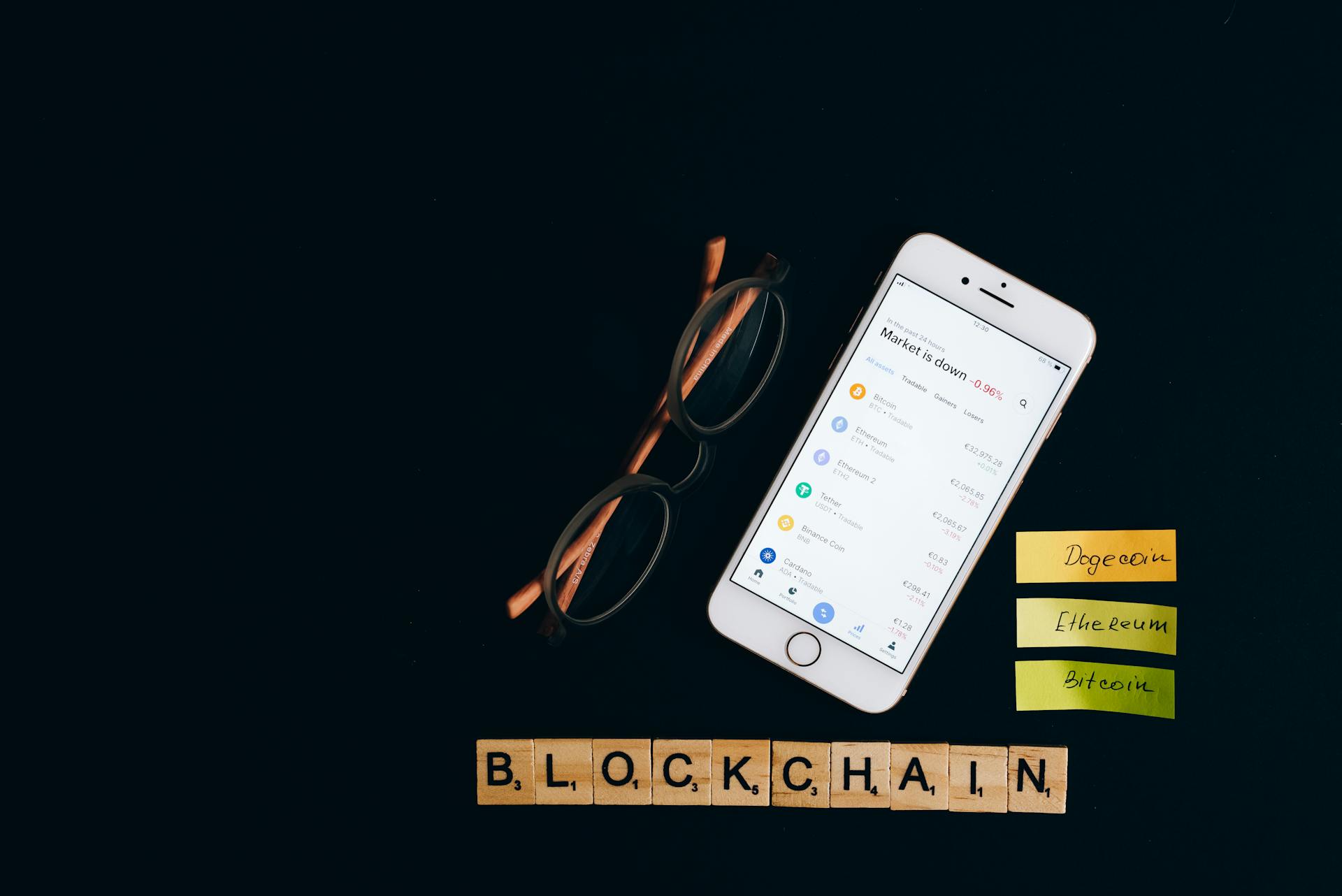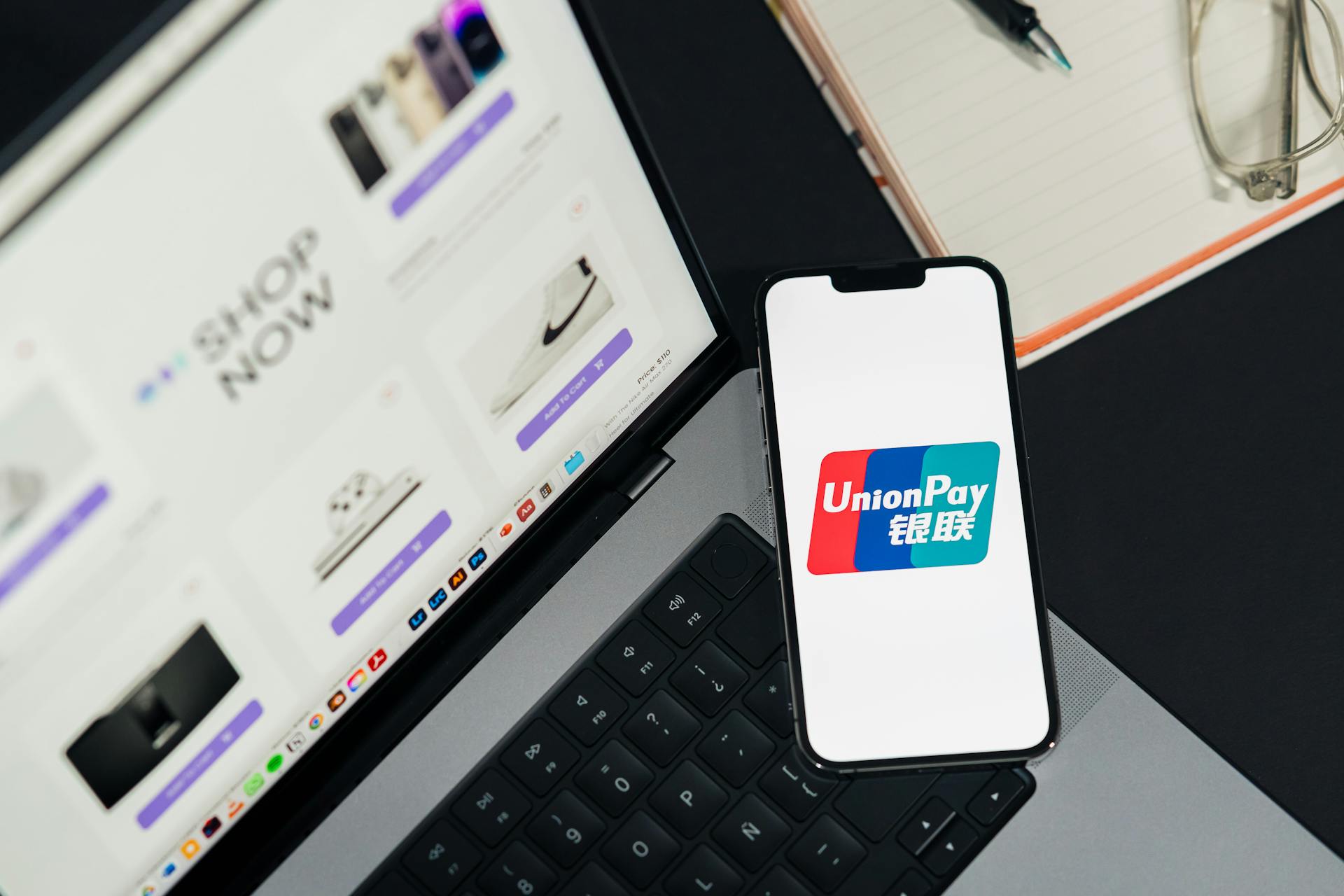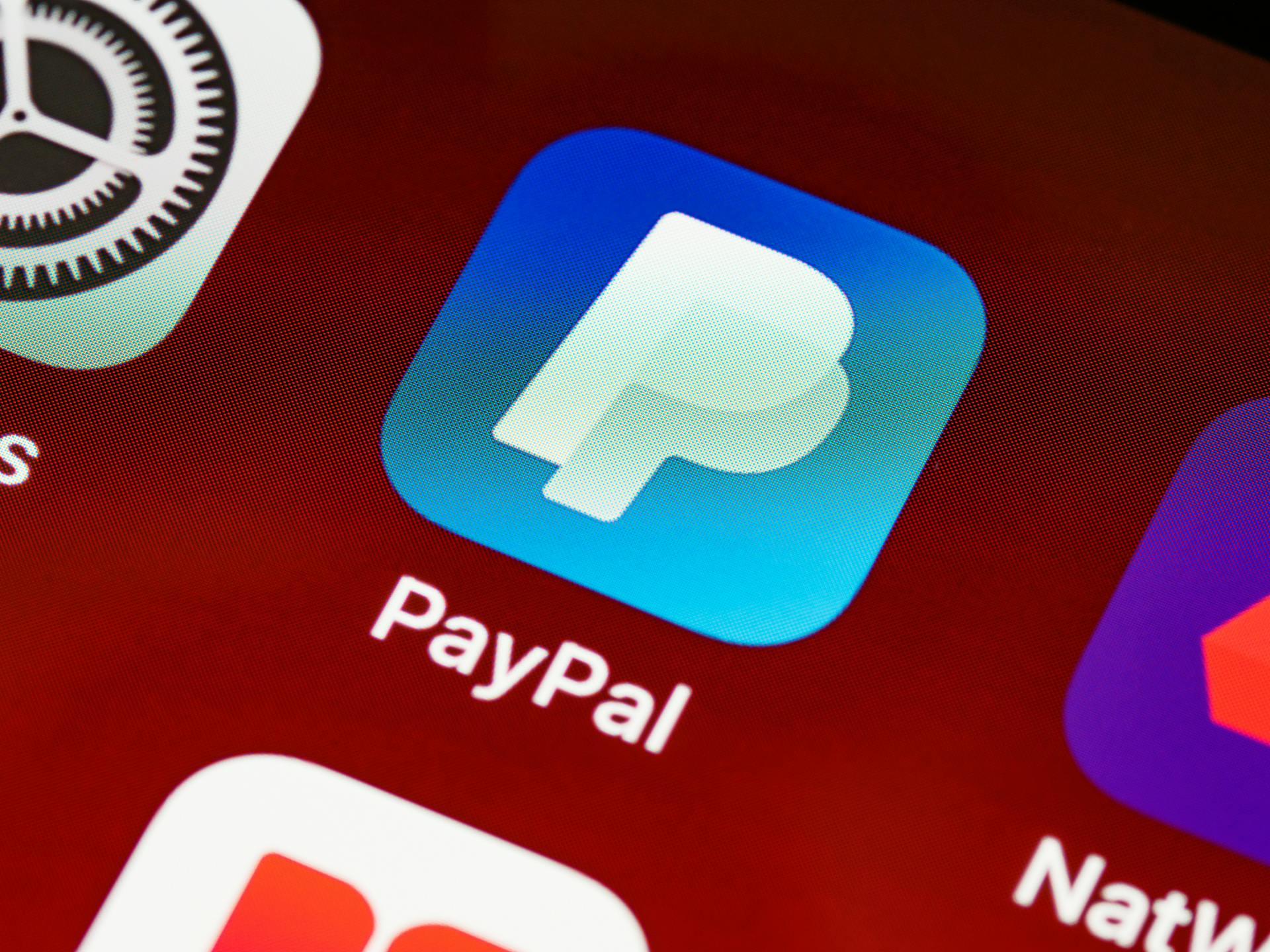
Decentralized applications, or dApps, are revolutionizing the way we think about software and the internet. They're built on blockchain technology, which allows for a decentralized and transparent network.
One of the key benefits of dApps is that they're open-source, meaning anyone can access and contribute to their code. This transparency and community-driven approach can lead to faster development and more secure software.
A great example of a dApp is Augur, a decentralized prediction market that allows users to create and participate in predictions on various topics. It's built on the Ethereum blockchain and has gained significant traction in the crypto community.
Decentralized applications are also known for their autonomy, meaning they can operate independently of central authorities or intermediaries. This can lead to more efficient and cost-effective solutions, as well as greater user freedom and control.
What Are Decentralized Apps?
Decentralized apps, or dApps, operate on a blockchain or peer-to-peer network of computers.
Users engage in transactions directly with one another, rather than relying on a central authority to facilitate them. This means they don't need to trust that the other party will execute their part of a transaction.
The source code for dApps nearly always uses smart contracts, which complete transactions between people. Smart contracts are a key feature of decentralized apps.
Decentralized apps are often free, but users might need to pay the developer in cryptocurrency to download and use the program's source code.
Key Concepts
Decentralized applications, or dApps, run on a blockchain network of computers instead of a single computer. This means they're free from the control and interference of a single authority.
DApps are designed to safeguard user privacy and lack censorship, offering flexibility in development. However, they can struggle with scaling, developing user interfaces, modifying code, and security issues.
Here are the key differences between traditional apps and dApps:
DApps operate on blockchain technology, enabling transparent and decentralized transaction processing and consensus mechanisms. This trustless system allows users to interact directly with the blockchain network without relying on a central authority or intermediaries.
Benefits and Uses
Decentralized applications (DApps) are revolutionizing the way we interact with digital assets and data. They offer a range of benefits, including decentralization, which ensures that DApps are not controlled by a single entity.
DApps can automate operational processes, such as matching buyers and sellers of assets in a decentralized manner, cutting broker costs and increasing efficiency. This can be seen in financial applications, where DApps facilitate peer-to-peer financial transactions, such as currency exchanges or asset transfers.
Some of the key uses of DApps include:
- Financial services: Facilitating peer-to-peer financial transactions, such as currency exchanges or asset transfers.
- Supply chain management: Tracking the movement of goods through a supply chain, ensuring transparency and accountability.
- Identity verification: Securely storing and verifying identity information, such as for voter rolls or passport applications.
- Real estate: Facilitating real estate transactions directly between buyer and seller, tracking property ownership and related documentation, such as deeds.
- Healthcare: Storing and tracking healthcare records and facilitating communications between healthcare professionals.
- Social media: Creating decentralized social media platforms that allow users to interact and share content without being censored by a centralized authority.
DApps also offer enhanced security, transparency, and autonomy, making them more secure against data breaches and giving users better control over their data and assets. As awareness and understanding of blockchain technology grow, DApps have the potential to become more widely adopted, enabling more control over digital assets and data.
What Are the Benefits of?
Decentralization is at the heart of DApps, ensuring that they're not controlled by a single entity. This means users have more control over their data and assets.

DApps can automate operational processes, such as matching buyers and sellers of assets in a decentralized manner, allowing applications to often cut broker costs. This leads to better efficiency.
The tamper-proof nature and cryptographic security of blockchain technology make DApps more secure against data breaches. This is a significant advantage over traditional centralized systems.
DApps typically operate on public blockchains, allowing users to view and verify transactions and data. This fosters trust and transparency in their operations.
DApps are self-executing and don't require intermediaries, giving users better control over their data and assets without relying on third parties. This autonomy is a key benefit of DApps.
Here are some key benefits of DApps at a glance:
- Decentralization: Ensures no single entity controls the DApp.
- Better efficiency: Automates operational processes, reducing costs.
- Enhanced security: Leveraging blockchain technology's tamper-proof nature.
- Transparency: Operating on public blockchains, allowing users to verify transactions.
- Autonomy: Self-executing and doesn't require intermediaries.
8 Benefits of Cryptocurrency & Why You Should Use It
Cryptocurrencies offer a growing number of benefits, far from being a passing fad. They provide a secure and decentralized way to make transactions, free from the control of governments and financial institutions.
One of the main benefits of cryptocurrency is its ability to offer fast and low-cost transactions. This is especially beneficial for international transactions, where traditional payment methods can be slow and expensive.
With cryptocurrency, you can make transactions 24/7, without the need for intermediaries like banks. This makes it a great option for people who want to send or receive money quickly and easily.
Cryptocurrency also offers a high level of security, thanks to its use of advanced cryptography. This makes it virtually impossible for hackers to steal or manipulate your funds.
Another benefit of cryptocurrency is its transparency. All transactions are recorded on a public ledger, called a blockchain, which provides a clear and tamper-proof record of all transactions.
By using cryptocurrency, you can also have more control over your financial transactions. You can send and receive money without the need for intermediaries, and you can even use it to make purchases online.
Cryptocurrency also offers a sense of community, with many users and developers working together to improve and expand its use. This has led to the creation of a wide range of cryptocurrencies, each with its own unique features and benefits.
You might like: Fiat Money News
Challenges and Considerations
Dapps can be very expensive to run when Ethereum grows more congested with users, making scalability a significant challenge.
Limited transaction processing capabilities on some blockchains can result in slower performance and higher fees, affecting a DApp's growth potential.
Many DApps still have centralized elements, such as user interfaces, while the smart contract running inside is truly decentralized, making full decentralization a work in progress.
Users are at risk of losing funds if they're unaware of what they agree to when using dApps, highlighting the need for consumer protection and education.
DApps may have complex user interfaces that are not as intuitive or user-friendly as traditional apps, making it more challenging for newcomers to navigate and fully utilize the DApp's features.
Security
Security is a top concern when using dApps, and for good reason. With over 312 hacks and vulnerabilities affecting dApps in 2022, resulting in losses of around $48 billion, it's clear that security is a major challenge.
The decentralized nature of dApps can make it difficult to track or hold perpetrators accountable, which is why users need to be cautious and do their due diligence when interacting with dApps.
One way that dApps can improve security is by leveraging blockchain technology, which makes data immutable by using cryptographic techniques and distributed automated consensus. This means that once data is recorded on the blockchain, it can't be altered.
The risk of losing funds is real, as platforms like MetaMask warn users to be aware of what they agree to when using dApps. In fact, users can lose funds if they're unaware of what they're agreeing to.
To put this into perspective, financial losses from hacks and exploits decreased by 96% in 2023, but the frequency of these incidents increased by 17.3%. In the first quarter of 2024, losses increased by 9% to $407 million compared to Q1 2023's $373 million.
It's essential for users to be aware of these risks and take steps to protect themselves when using dApps.
Challenges Faced by Apps
DApps face several challenges that hinder their growth and adoption.
One major challenge is the high cost of running DApps when the underlying network is congested, making it difficult for users to access and use the application.
Lack of scalability is another significant issue, with some blockchains struggling to process transactions efficiently, leading to slower performance and higher fees.
A complex user interface can also be a barrier to entry for newcomers, making it harder for them to navigate and fully utilize the DApp's features.
Many DApps are not fully decentralized, with some elements still being centralized, such as a centralized user interface, which can undermine the true potential of decentralized technology.
CryptoKitties, a popular example of a DApp, is a blockchain-based virtual game that demonstrates the unique capabilities of decentralized applications.
Uniswap, another example, is a decentralized exchange protocol built on Ethereum, showing how DApps can provide secure and seamless trading experiences for users.
Regulatory Considerations
Regulatory bodies face unique challenges when it comes to decentralized applications, or dApps. Traditional regulatory frameworks are often based on a specific location, but dApps operate outside of these boundaries.
Decentralized nature is a primary challenge for regulators. It's tougher to regulate activity based on where transactions occur.
Regulators struggle to pinpoint the location of dApps, making it difficult to enforce rules and regulations. This lack of centralization creates a regulatory gray area.
How They Work
Decentralized applications, or dapps, use blockchain technology to connect users directly and put them in control of their data. This means users don't have to go through a third party, making it difficult for central entities to stop transactions or delete data.
Dapps are built on top of blockchains, such as Ethereum, which provide a decentralized system where each user has a copy of the records. This allows users to interact with each other directly, without needing an intermediary.
The key characteristics of a dapp include being open source, decentralized, using blockchains, smart contracts, and being global. Here are the key characteristics in a concise list:
- Open source: The code is public for anyone to look at, copy and audit.
- Decentralized: Dapps don’t have anyone in charge, so no central authority can stop users from doing what they want on the app.
- Blockchains: If there isn't a central entity, then what's holding the app together? Dapps use an underlying blockchain (such as Ethereum) to coordinate instead of a central entity.
- Smart contracts: Decentralized applications use Ethereum smart contracts, which automatically executes certain rules.
- Global: The goal is for anyone in the world to be able to publish or use these dapps.
How Dapps Work
Dapps use blockchain technology under the hood to connect users directly, allowing them to interact without needing a central authority. This means users don't have to give up control of their data to someone else.
Blockchains are a way to tie together a distributed system, where each user has a copy of the records. This is a key characteristic of dapps, making them decentralized and resistant to control by a single entity.
Dapps don't have anyone in charge, so no central authority can stop users from doing what they want on the app. This is made possible by the use of an underlying blockchain, such as Ethereum, to coordinate instead of a central entity.
Here are the key characteristics of a dapp:
- Open source: The code is public for anyone to look at, copy and audit.
- Decentralized: Dapps don’t have anyone in charge, so no central authority can stop users from doing what they want on the app.
- Blockchains: If there isn't a central entity, then what's holding the app together? Dapps use an underlying blockchain (such as Ethereum) to coordinate instead of a central entity.
- Smart contracts: Decentralized applications use Ethereum smart contracts, which automatically execute certain rules.
- Global: The goal is for anyone in the world to be able to publish or use these dapps.
Etherisc
Etherisc is a decentralized application that improves the travel industry by allowing users to buy or sell insurance for flight delays and cancellations.
Using the Ethereum blockchain, each insurance agreement is available to view on a public database, making it transparent and secure.
Once an insurance contract has been agreed upon, it is impossible to change, giving users peace of mind.
There are many different insurance packages to invest in, all with a different level of risk, so users can choose what works best for them.
Decentralization allows users to receive payments as soon as the outcome of the event is verified, thanks to smart-contract technology.
Golem
Golem is a decentralized platform that allows users to rent out their extra computing power in return for its own token, GNT. It's a peer-to-peer system, where users can hire computing power from others directly.
The Golem dApp operates independently of the platform's network, ensuring a completely decentralized experience. This means that transactions are not controlled by any central authority.
Users can rent out their computing power for a wide range of applications, including GamblingAdvertisingAccountingBankingInsuranceLoans and MortgagesIdentity VerificationReal Estate…and many, many others!
Frequently Asked Questions
What is the future of DApps?
What can we expect from the future of DApps? They will operate faster, cheaper, and more seamlessly across multiple blockchains
Sources
- https://www.investopedia.com/terms/d/decentralized-applications-dapps.asp
- https://www.fool.com/terms/d/decentralized-application/
- https://www.coindesk.com/learn/what-is-a-decentralized-application
- https://www.bitdegree.org/crypto/tutorials/decentralized-applications
- https://algorand.co/learn/what-is-a-dapp-decentralized-apps-explained
Featured Images: pexels.com


